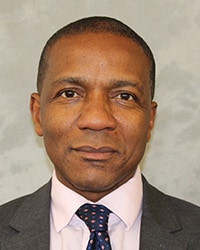
Dr Jude Oben
Gastroenterologists have been challenged to step up to obesity-induced liver disease – a more realistic term which addresses the underlying issue in non-alcoholic fatty liver disease (NAFLD).
Dr Jude Oben, a gastroenterologist and hepatologist from Guy’s and St Thomas’ Hospital in London, told AGW 2019 there should be ‘no excuses’ in discussions with patients.
However clinicians should also be prepared to upskill so they can offer something more effective than generic lifestyle advice.
“If your patient already weighs 190 kg, the idea of telling them to go and do lifestyle change isn’t going to work. You have to offer patients something else.”
Dr Oben said in the absence of pharmaceutical options for NAFLD, endoscopic intragastric balloons were something that gastroenterologists could offer – either alone or as a bridge to bariatric surgery.
He said lifestyle advice wasn’t ignored in his centre and patients were “fussed over” with, for example, monthly group meetings where all the patients come together either before or after their procedures to talk and “feel more loved”.
It was important to get to know patients and better understand their specific issues with food, he added.
His patients are encouraged to lose 5% of their body weight before the balloon is fitted.
“I try to say to them that when the balloon comes out their relationship with food needs to change. Because if it doesn’t change, just like with bariatric surgery, in time all patients will regain the weight.”
He said patients could lose up to 30% of their bodyweight with the balloons, which were inserted for six months.
“I’ve negotiated with our funders that every patients can have up to three balloons.”
He is also developing an endoscopic sleeve gastrectomy and beyond that patients can consider surgery although the waitlist is 18 months to two years.
“Or if they have done very well they don’t need surgery but at least we have got a spectrum of procedures to offer them.”
Dr Oben said a 2019 position statement from the European Association for the Study of Liver (EASL) estimated the annual direct cost of NAFLD in Europe was at about the Australian equivalent of $57 billion. Societal costs added a further $322 billion.
And a recent American Association for the Study of Liver Diseases publication estimated lifetime costs of all NASH patients in the US would be $222.6 billion.
“The economic burden of NAFLD is overwhelming,” he told the meeting.
Across the world NASH was the most rapidly growing indication for liver transplant and likely to soon reach the top position.
Unfortunately, some people were so morbidly obese they did not qualify for transplant.
“This is the biggest health threat at the moment. This is the HIV of the age,” he told the limbic.
“It’s not just a call to my colleagues. It is actually to everyone because if you don’t change, it is costing you as taxpayers a huge amount of money and quite frankly, it’s killing our patients.”